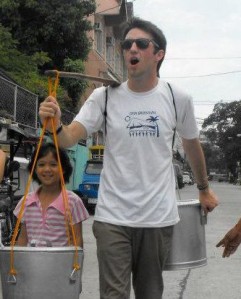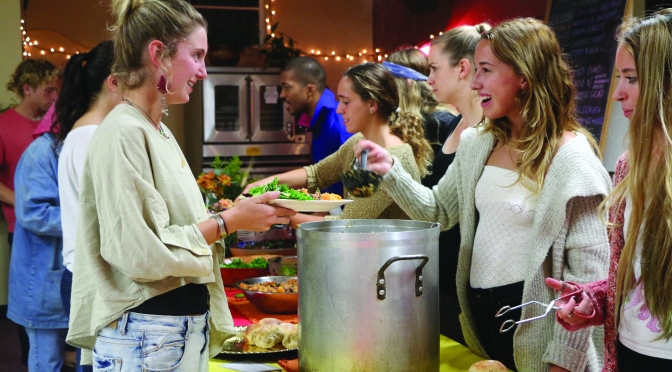One of the best-kept secrets at the University of San Francisco is that there is an urban community garden behind the Education Building on Turk Street. The garden sits on 1/8 of an acre, and grows a number of fruits, vegetables, and herbs. Students, faculty, and community members passionate about nature visit the garden weekly to grow, eat, and connect with the environment. The USF Community Garden, however, cultivates more than just produce.
What used to be an ROTC training field is now an outdoor classroom and sacred space for students and community members with a green thumb. Working in the urban garden promotes sustainable food consumption and service learning, and links the community back to nature.
Professors Melinda Stone and Seth Wachtel established the garden in 2007 as part of a new living learning community called “The Garden Project,” where students agreed to regularly volunteer their time to the garden. When more students became interested in learning about sustainable foods, USF created the urban agriculture minor.
Today, the garden serves multiple purposes.
USF’s community garden is, for one, an outdoor classroom for urban agriculture students and students in the Community Garden Outreach service learning class. David Silver, associate professor of media studies and environmental studies, described the garden as “a living laboratory” because students can learn hands-on about agriculture, sustainability, and giving back.
Silver mentioned that the garden is also, and foremost, a place of food production. “We produce a ton of food which goes into the farm stand,” he said. Silver is referring to the occasional farm stands on-campus hosted by community garden volunteers, where students and faculty can purchase whole meals — mainly, salads, soups, and desserts — made with fresh, seasonal ingredients from the garden.
The garden serves many people beyond the USF community, as well. According to Silver, the produce also goes towards a free community dinner at St. Cyprian’s Church, located down the street, on Turk and Lyon. The monthly dinner, also hosted by community garden volunteers, serves an average of 80 to 100 people. The remaining food is donated to Booker T. Washington’s food bank, said Silver. Last Friday, students from Raoul Wallenberg Traditional High School visited the garden to learn and lend a hand.
The garden also serves as what Silver calls “a site of reflection” for students and professors. Silver says the garden is an excellent place to log off, relax, breath fresh air, and simply be in nature.
Seniors Sam Wilder and Paul Krantz use the garden to seek refuge from their busy college lives. Wilder, who is highly passionate about urban farming and knowing where his food comes from, calls the garden, “my little slice of paradise.” Like other students, he uses the garden to further his knowledge in sustainable, local, and organic produce. He said it feels like people have lost the connection between growing and consuming food. “The USF garden reconnects us to our food and our earth. Participating in the garden makes me feel like I’m doing something right and it makes me happy.”
Silver thinks it is important for future generations to “learn the opposite of the digital and actually work with your hands, in the dirt, to create something, and then actually [eat] it.” Volunteers spend hours in the garden, digging, planting, and cultivating, but after each workday, participants are welcome to take what they please from the garden.
Both Silver and Wilder believe it is important for Americans to rethink their means of nourishment. The distribution of food requires tremendous amount of energy and resources to get the product from the farm to the table, they explain. Urban farming could be a solution to this unhealthy habit of consumption.
Urban Gardens are springing up all over San Francisco and other big cities. The San Francisco Urban Agriculture Alliance reports that today, commercial garden and small farm sites are now legal, city-wide. It states: “This ordinance allows properly permitted and code-abiding gardeners and farmers to sell any produce they grow directly to the public on site. Growers were previously required to haul their bounty to a third party commercial zone, like a farmers market, or sell through a distributor.”
The California Food Policy Council (CAFPC) also promotes policies that develop urban agriculture and ensure protection of the environment. Community gardens serve as vibrant sustainable food systems that protect and restore the environment and natural resources.
According to Anne Carter of the Community Food Systems Lab, “use of organic agricultural practices will decrease further introduction of chemicals to city soils and water supply.”
The community garden at USF is constantly evolving, and the most recent additions include a greenhouse and worm bin. Silver believes that the mild temperature in the garden grows the best brassicas, a genus of plant from the mustard family, like kale and Swiss chard.
Silver and Wilder encourage students and community members to visit the garden and come to the work days, held each Friday afternoon from 2 to 5 p.m.





